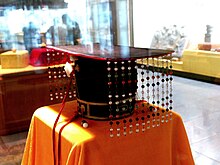
Back Mianguan Catalan Mian guan German Mianguan French 冕冠 GAN 冕冠 (中国) Japanese 면류관 Korean 冕冠 WUU 冕冠 Chinese 冕冠 ZH-YUE
This article needs additional citations for verification. (January 2022) |

The mianguan (Chinese: 冕冠; pinyin: miǎnguān; lit. 'ceremonial headdress'), also called benkan in Japan, myeonlyugwan in Korea, and Miện quan in Vietnam, is a type of crown traditionally worn by the emperors of China, Japan, Korea, and Vietnam, as well as other kings in East Asia.[1]
Originating in China, the mianguan was worn by the emperor, his ministers,[2] and aristocrats.[3] The mianguan was the most expensive Chinese headware, reserved for important sacrificial events.[2] Regulations on its shape and its making were issued under the Eastern Han dynasty and applied in the succeeding dynasties only to be ended at the fall of the Ming dynasty in the 16th century AD.[2]
In Japan, emperors and nobles wore gold, silver, and gilt-bronze crowns, influenced by the Korean peninsula, from the Kofun period (mid 3rd century-7th century). In the 8th century, influenced by the Chinese mianguan, the unique benkan was born, a metal crown with chains and a sun-shaped ornament at the top.[4]
It is also worn in Vietnam,[a] and the monarchs of the Joseon dynasty also wore an equivalent crown, the myeonlyugwan.
- ^ 字通,世界大百科事典内言及, 精選版 日本国語大辞典,ブリタニカ国際大百科事典 小項目事典,デジタル大辞泉,普及版. "冕冠とは". コトバンク (in Japanese). Retrieved 2022-01-18.
{{cite web}}: CS1 maint: multiple names: authors list (link) - ^ a b c Hua, Mei (2011). Chinese clothing (Updated ed.). Cambridge, United Kingdom. p. 54. ISBN 978-0-521-18689-6. OCLC 781020660.
{{cite book}}: CS1 maint: location missing publisher (link) - ^ 5000 years of Chinese costumes. Xun Zhou, Chunming Gao, 周汛, Shanghai Shi xi qu xue xiao. Zhongguo fu zhuang shi yan jiu zu. San Francisco, CA: China Books & Periodicals. 1987. pp. 32, 34. ISBN 0-8351-1822-3. OCLC 19814728.
{{cite book}}: CS1 maint: others (link) - ^ Hachijo, Tadatomo (2021-03-09). 日本の装束解剖図鑑 [Anatomy Illustrated Book of Japanese Costumes] (in Japanese). X-Knowledge. pp. 14–15. ISBN 978-4767828619.
- ^ "Special Exhibition "The Great Vietnam Exhibition"" (in Japanese). Kyushu National Museum. Archived from the original on 2013-03-28. Retrieved 2013-05-12.
Successive Emperors of the Nguyen Dynasty wore a crown called a Benkan, which had a rectangular plate on top of its head and twelve [strings] of colorful beads lined up [on a] red string in the front and back [each].
Cite error: There are <ref group=lower-alpha> tags or {{efn}} templates on this page, but the references will not show without a {{reflist|group=lower-alpha}} template or {{notelist}} template (see the help page).